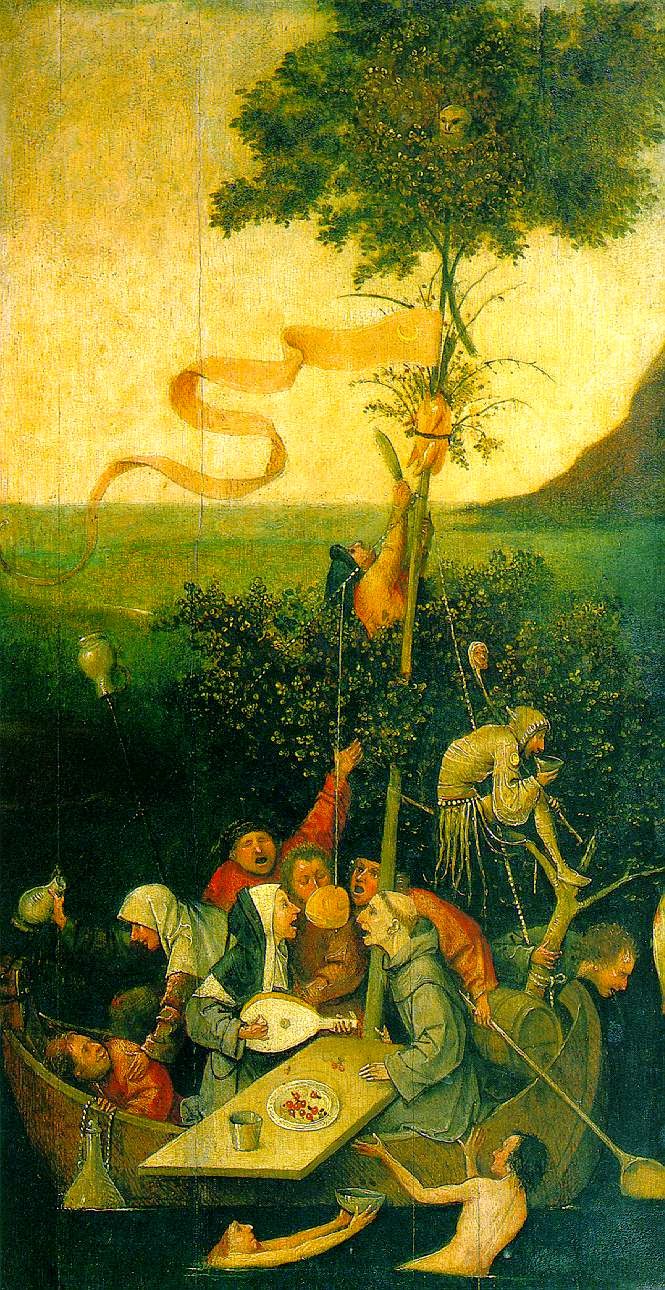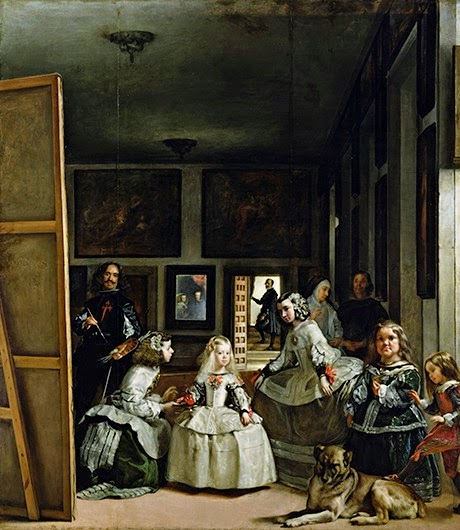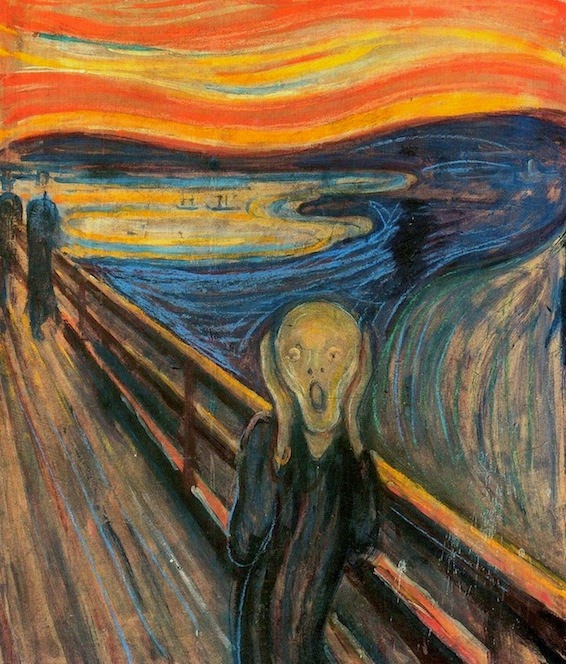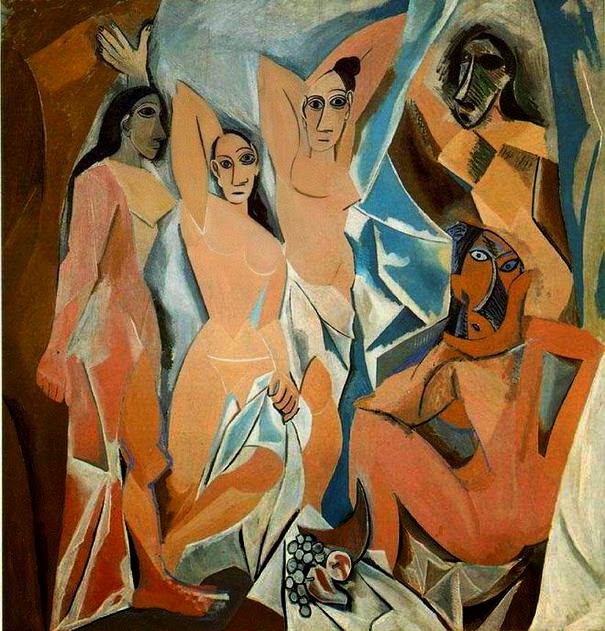Nowadays, art collectors often spend all of their money to own the world’s most precious paintings. However, the most expensive paintings are not necessarily the most famous ones. The following list includes both famous and less famous paintings that will take your breath away. Let's take a look at them and read some information about them below:

The Ship of Fools is amongst the Louvre’s most delicate and piercingly luminous images, its motley crew stitched together with inspired invention and impeccable craft to elucidate a timeless moral question. Painted by Hieronymous Bosch around 1500, The Ship of Fools was presumably inspired after Sebastien Brant’s book of satirical poems of the same title, published in 1494. In the picture, a ship of fools is adrift on a calm sea, a slender tree taking place of a mast, an owl or death mast half hidden amongst its foliage. The principal group of figures centers around a table over which preside a monk and a nun, busy either singing or trying to eat a suspended crêpe without their hands, an activity made more difficult by the agitation of the line by a fellow reveler. In The Ship of Fools Bosch is imagining that the whole of mankind is voyaging through the seas of time on a ship, a small ship, that is representative of humanity.

The Beheading of St John the Baptist was completed in 1608 and depicts the saint at the moment of his martyrdom. The executioner holds down his head whilst the janitor instructs him to finish the job. An old lady clasps her head in horror whilst the young woman, possibly Salome, holds a large charger to receive the head. Caravaggio's name is scrawled in the blood oozing out of St John’s neck.This is a final compendium of Caravaggio's art. The technical means adhere to the deliberate, programmatic limitation to which Caravaggio adapts them; but amid these soft tones, these dark colours, is an impressive sense of drawing that the artist does not give up, and that is visible even through the synoptic glints of light of his late works.

Las Meninas is the masterpiece of Spanish painting, and one of the most important paintings in the world. It is probably the most controversial, talked about, analyzed and imitated painting in history. Las Meninas allows the spectator to freely interact with the painting’s various contradictory points of view and therefore offers him a fuller understanding of the painting’s emotional and intellectual depth. The painting represents a scene from daily life in the palace of Felipe IV. In the painting we see Princess Margarita in the centre accompanied by her ladies-in-waiting (“meninas”); doña Marcela of Ulloa who is speaking to Diego Ruíz Azcona; Velázquez himself painting; José Nieto Velázquez in a doorway at the back of the painting; and on the wall at the back there is a mirror reflecting the image of the monarchs King Felipe IV and Mariana of Austria.

Between the years of 1819 and 1823, Goya painted a series of paintings on the walls his villa at Quinto del Sordo, all of which portrayed terrible, fantastical, or morbid imagery. These paintings are now called the Black Paintings, referring to the mental state of Goya during this dark time in his life, due to his bout with illness, which made him deaf, as well internal strife in Spain. This painting was completed of the walls of his dining room, and is a rendition of Saturn, the Roman mythological character, who, fearing that his children would one day overthrow him, ate each one of them upon their births. According to the traditional interpretation, it depicts the Greek myth of the Titan Cronus (in the title Romanised to Saturn), who, fearing that he would be overthrown by one of his children, ate each one upon their birth.

Vincent van Gogh's The Cafe Terrace stands as one of the painter's most remarkable works. It is also, without question, one of the most famous produced in Van Gogh's brief but prolific career. Visitors of the site can still stand at the northeastern corner of the Place du Forum, where the artist set up his easel. He looked south towards the artificially lit terrace of the popular coffee house, as well as into the enforced darkness of the rue du Palais leading up to the building structure and, beyond this structure, the tower of a former church. Towards the right, Van Gogh indicated a lighted shop as well, and some branches of the trees surrounding the place—but he omitted the remainders of the Roman monuments just beside this little shop.

The Scream is the popular name given to each of four versions of a composition, created as both paintings and pastels, by the Expressionist artist Edvard Munch between 1893 and 1910. The Scream was painted after the end of the photographic Realist era, when artists wanted to show off their technical skills. The Scream was also painted right before the Expressionists and other artists of the early twentieth century made it a trend to put a focus on the expression of their inner feelings and emotions through their art rather than displaying how realistically they could paint an image or object. This famous picture is autobiographical, an expressionistic construction based on Munch's actual experience of a scream piercing through nature while on a walk, after his two companions, seen in the background, had left him.

This painting is the most famous example of cubism painting. In this painting, Picasso abandoned all known form and representation of traditional art. He used distortion of female's body and geometric forms in an innovative way, which challenge the expectation that paintings will offer idealized representations of female beauty. It also shows the influence of African art on Picasso. It depicts five naked women with figures composed of flat, splintered planes and faces inspired by Iberian sculpture and African masks. The compressed space the figures inhabit appears to project forward in jagged shards; a fiercely pointed slice of melon in the still life of fruit at the bottom of the composition teeters on an impossibly upturned tabletop.

The theme of a pair of lovers, united through a kiss, was one that occupied Klimt throughout his career. Variations on this theme can be found early on in his works. Analysis of Gustav Klimt’s the Kiss shows the painting embracing both the linear and geometric shapes of the contemporary Art Nouveau style and the flowing organic forms of the Art and Crafts movement. Gustav Klimt’s painting uses oil paints and sections of gold leaf to create an evocative, resonating image that captures the eye on a purely physical level and taps into ageless themes of love and ecstasy. Klimt depicts the couple locked in intimacy, while the rest of the painting dissolves into shimmering, extravagant flat pattern.

Dali sometimes referred to his paintings as “hand-painted dream photographs” and The Persistence of Memory can certainly be characterized as such. It epitomizes Dalí's theory of "softness" and "hardness", which was central to his thinking at the time. Time is the theme here, from the melting watches to the decay implied by the swarming ants. He based this seaside landscape on the cliffs in his home region of Catalonia, Spain. The ants and melting clocks are recognizable images that Dalí placed in an unfamiliar context or rendered in an unfamiliar way. The large central creature comprised of a deformed nose and eye was drawn from Dalí’s imagination, although it has frequently been interpreted as a self-portrait.

Pain and suffering, often illustrated in a straightforward and horrifying way, is a constant topic in Frida's painting. Kahlo was 18 years old when she was involved in a horrific traffic accident, in which an iron rod pierced her abdomen, right foot was crushed, and two vertebrae were fractured, as well as a number of other bones, including eleven fractures in her right leg. In this painting, we see Frida Kahlo nude, except for a sheet that is wrapped around her foreshortened lower body, and the widely spaced straps of an upper-body corset. The center of her upper body is vertically torn open from neck to pubic region to reveal an Ionic column that is split horizontally in numerous places. The expression on the woman's face is serious, but you can see the tears running from her eyes.
Related:
Ship Of Fools by Hieronymus Bosch (1490-1500)

The Ship of Fools is amongst the Louvre’s most delicate and piercingly luminous images, its motley crew stitched together with inspired invention and impeccable craft to elucidate a timeless moral question. Painted by Hieronymous Bosch around 1500, The Ship of Fools was presumably inspired after Sebastien Brant’s book of satirical poems of the same title, published in 1494. In the picture, a ship of fools is adrift on a calm sea, a slender tree taking place of a mast, an owl or death mast half hidden amongst its foliage. The principal group of figures centers around a table over which preside a monk and a nun, busy either singing or trying to eat a suspended crêpe without their hands, an activity made more difficult by the agitation of the line by a fellow reveler. In The Ship of Fools Bosch is imagining that the whole of mankind is voyaging through the seas of time on a ship, a small ship, that is representative of humanity.
The Beheading of Saint John the Baptist by Caravaggio (1608)

The Beheading of St John the Baptist was completed in 1608 and depicts the saint at the moment of his martyrdom. The executioner holds down his head whilst the janitor instructs him to finish the job. An old lady clasps her head in horror whilst the young woman, possibly Salome, holds a large charger to receive the head. Caravaggio's name is scrawled in the blood oozing out of St John’s neck.This is a final compendium of Caravaggio's art. The technical means adhere to the deliberate, programmatic limitation to which Caravaggio adapts them; but amid these soft tones, these dark colours, is an impressive sense of drawing that the artist does not give up, and that is visible even through the synoptic glints of light of his late works.
Las Meninas by Velázquez (1656)

Las Meninas is the masterpiece of Spanish painting, and one of the most important paintings in the world. It is probably the most controversial, talked about, analyzed and imitated painting in history. Las Meninas allows the spectator to freely interact with the painting’s various contradictory points of view and therefore offers him a fuller understanding of the painting’s emotional and intellectual depth. The painting represents a scene from daily life in the palace of Felipe IV. In the painting we see Princess Margarita in the centre accompanied by her ladies-in-waiting (“meninas”); doña Marcela of Ulloa who is speaking to Diego Ruíz Azcona; Velázquez himself painting; José Nieto Velázquez in a doorway at the back of the painting; and on the wall at the back there is a mirror reflecting the image of the monarchs King Felipe IV and Mariana of Austria.
Saturn Devouring His Son by Francisco Goya (1819-1823)

Between the years of 1819 and 1823, Goya painted a series of paintings on the walls his villa at Quinto del Sordo, all of which portrayed terrible, fantastical, or morbid imagery. These paintings are now called the Black Paintings, referring to the mental state of Goya during this dark time in his life, due to his bout with illness, which made him deaf, as well internal strife in Spain. This painting was completed of the walls of his dining room, and is a rendition of Saturn, the Roman mythological character, who, fearing that his children would one day overthrow him, ate each one of them upon their births. According to the traditional interpretation, it depicts the Greek myth of the Titan Cronus (in the title Romanised to Saturn), who, fearing that he would be overthrown by one of his children, ate each one upon their birth.
Café Terrace at Night by Vincent Van Gogh (1888)

Vincent van Gogh's The Cafe Terrace stands as one of the painter's most remarkable works. It is also, without question, one of the most famous produced in Van Gogh's brief but prolific career. Visitors of the site can still stand at the northeastern corner of the Place du Forum, where the artist set up his easel. He looked south towards the artificially lit terrace of the popular coffee house, as well as into the enforced darkness of the rue du Palais leading up to the building structure and, beyond this structure, the tower of a former church. Towards the right, Van Gogh indicated a lighted shop as well, and some branches of the trees surrounding the place—but he omitted the remainders of the Roman monuments just beside this little shop.
The Scream by Edvard Munch (1893)

The Scream is the popular name given to each of four versions of a composition, created as both paintings and pastels, by the Expressionist artist Edvard Munch between 1893 and 1910. The Scream was painted after the end of the photographic Realist era, when artists wanted to show off their technical skills. The Scream was also painted right before the Expressionists and other artists of the early twentieth century made it a trend to put a focus on the expression of their inner feelings and emotions through their art rather than displaying how realistically they could paint an image or object. This famous picture is autobiographical, an expressionistic construction based on Munch's actual experience of a scream piercing through nature while on a walk, after his two companions, seen in the background, had left him.
Les Demoiselles d’Avignon by Pablo Picasso (1907)

This painting is the most famous example of cubism painting. In this painting, Picasso abandoned all known form and representation of traditional art. He used distortion of female's body and geometric forms in an innovative way, which challenge the expectation that paintings will offer idealized representations of female beauty. It also shows the influence of African art on Picasso. It depicts five naked women with figures composed of flat, splintered planes and faces inspired by Iberian sculpture and African masks. The compressed space the figures inhabit appears to project forward in jagged shards; a fiercely pointed slice of melon in the still life of fruit at the bottom of the composition teeters on an impossibly upturned tabletop.
The Kiss by Gustav Klimt (1908)

The theme of a pair of lovers, united through a kiss, was one that occupied Klimt throughout his career. Variations on this theme can be found early on in his works. Analysis of Gustav Klimt’s the Kiss shows the painting embracing both the linear and geometric shapes of the contemporary Art Nouveau style and the flowing organic forms of the Art and Crafts movement. Gustav Klimt’s painting uses oil paints and sections of gold leaf to create an evocative, resonating image that captures the eye on a purely physical level and taps into ageless themes of love and ecstasy. Klimt depicts the couple locked in intimacy, while the rest of the painting dissolves into shimmering, extravagant flat pattern.
The Persistence of Memory by Salvador Dali (1931)

Dali sometimes referred to his paintings as “hand-painted dream photographs” and The Persistence of Memory can certainly be characterized as such. It epitomizes Dalí's theory of "softness" and "hardness", which was central to his thinking at the time. Time is the theme here, from the melting watches to the decay implied by the swarming ants. He based this seaside landscape on the cliffs in his home region of Catalonia, Spain. The ants and melting clocks are recognizable images that Dalí placed in an unfamiliar context or rendered in an unfamiliar way. The large central creature comprised of a deformed nose and eye was drawn from Dalí’s imagination, although it has frequently been interpreted as a self-portrait.
The Broken Column by Frida Kahlo (1944)

Pain and suffering, often illustrated in a straightforward and horrifying way, is a constant topic in Frida's painting. Kahlo was 18 years old when she was involved in a horrific traffic accident, in which an iron rod pierced her abdomen, right foot was crushed, and two vertebrae were fractured, as well as a number of other bones, including eleven fractures in her right leg. In this painting, we see Frida Kahlo nude, except for a sheet that is wrapped around her foreshortened lower body, and the widely spaced straps of an upper-body corset. The center of her upper body is vertically torn open from neck to pubic region to reveal an Ionic column that is split horizontally in numerous places. The expression on the woman's face is serious, but you can see the tears running from her eyes.
Related:
- Workspaces Of Some Of The Greatest Artists Of The World (38 Pictures)
- The 10 Most Famous Personalities Of The Last 6,000 Years
- Top 14 Greatest Philosophers And Their Books
- The 15 Greatest Classical Composers Of All Time
- 15 Of Banksy’s Most Iconic Street Artworks
- Banksy Just Released This 2-Minute Film About Gaza, The Dream Holiday Destination For 2015
- My Jaw Dropped To The Floor When I Realized What This Image Really Was. WOW
- 28 Pieces Of Street Art That Cleverly Interact With Their Surroundings
- Shocking Effects Of Deforestation Exposed In Brutal Print Ads
- What if Animals Treated Us How We Treat Them?











COMMENTS